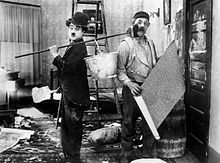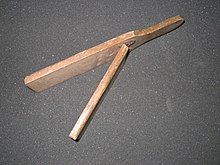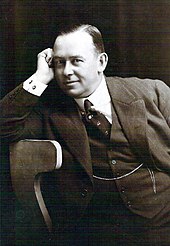Slapstick


Slapstickis a style ofhumorinvolvingexaggeratedphysical activity that exceeds the boundaries of normalphysical comedy.[1]Slapstick may involve both intentional violence and violence by mishap, often resulting from inept use of props such as saws and ladders.[2][3]
The term arises from a device developed for use in the broad, physical comedy style known ascommedia dell'artein 16th-century Italy. The "slap stick"consists of two thin slats of wood, which makes a" slap "when striking another actor, with little force needed to make a loud—and comical—sound. The physical slap stick remains a key component of the plot in the traditional and popularPunch and Judypuppet show. More contemporary examples of slapstick humor includeThe Three Stooges,The Naked GunandMr. Bean.
Origins[edit]
The name "slapstick" originates from the Italianbatacchioorbataccio—called the "slap stick"in English—a club-like object composed of two wooden slats used incommedia dell'arte.When struck, the Batacchio produces a loud smacking noise, though it is only a little force that is transferred from the object to the person being struck. Actors may thus hit one another repeatedly with great audible effect while causing no damage and only very minor, if any, pain. Along with the inflatable bladder (of which thewhoopee cushionis a modern variant), it was among the earliestspecial effects.
Early uses[edit]

Slapstick comedy's history is measured in centuries.Shakespeareincorporated many chase scenes and beatings into his comedies, such as in his playThe Comedy of Errors.
In early 19th-century England,pantomimeacquired its present form which includes slapstick comedy: its most famous performer,Joseph Grimaldi—the father of modernclowning—would partake in slapstick, with theSmithsonianstating he "fought himself in hilarious fisticuffs that had audiences rolling in the aisles".[4]Comedy routines also featured heavily in Britishmusic halltheatre which became popular in the 1850s.[5][6]
InPunch and Judyshows, which first appeared in England on 9 May 1662, a large slapstick is wielded by Punch against the other characters.[7]
Fred Karno[edit]

British comedians who honed their skills at pantomime andmusic hallsketches includeCharlie Chaplin,Stan Laurel,George FormbyandDan Leno.[8][9]The influential English music hall comedian and theatre impresarioFred Karnodeveloped a form of sketch comedy without dialogue in the 1890s, and Chaplin and Laurel were among the young comedians who worked for him as part of "Fred Karno's Army".[8]Chaplin's fifteen-year music hall career inspired the comedy in all his later film work, especially as pantomimicry.[10]In a biography of Karno, Laurel stated: "Fred Karno didn't teach Charlie [Chaplin] and me all we know about comedy. He just taught us most of it".[11]American film producerHal Roachdescribed Karno as "not only a genius, he is the man who originated slapstick comedy. We in Hollywood owe much to him."[12]
In film and television[edit]
Building on its later popularity in the 19th and early 20th-century ethnic routines of the Americanvaudevillehouse, the style was explored extensively during the "golden era" of black and white movies directed byHal RoachandMack Sennettthat featured such notables asCharlie Chaplin,Mabel Normand,Abbott and Costello,Laurel and Hardy,theThree Stooges,andLarry Semon.The "pie in the face" gag, in which one person hits another with a pie, became common in this era.[13]Silent slapstick comedy was also popular in early French films and included films byMax Linder,Charles Prince,andSarah Duhamel.[14]

Slapstick also became a common element in animated cartoons starting in the 1930; examples include Disney'sMickey MouseandDonald Duckshorts,Walter Lantz'sWoody Woodpecker,the Beary Family, MGM'sTom and Jerry,the unrelatedTom and Jerrycartoons ofVan Beuren Studios,Warner Bros.Looney Tunes/Merrie Melodies,MGM'sBarney Bear,and Tex Avery'sScrewy Squirrel.Slapstick was later used in JapaneseTokusatsuTVKamen Rider Den O,Kamen Rider Gaim,Kamen Rider Drive,byBenny HillinThe Benny Hill Showin the UK, and in the US used in the three 1960s TV series,Gilligan's Island,Batman,The Flying NunandI Love Lucy.[citation needed]
20th century fad[edit]
Use of the slapstick in public places was afadin the early 20th century.[citation needed]
During the 1911Veiled Prophet Paradein St. Louis, according to theSt. Louis Post-Dispatch,[15]
The slapstick, so long indispensable to low comedy, found a new use among the crowds... they used the slapstick to the extreme embarrassment of many women. The carnival spirit, for the most part tempered by high good humor, at times verged onrowdyism.Girls used a stick ripped with feathers to tickle the faces of young men, and they retaliated vigorously with the slapstick.
Aneditorialin theAsbury Park Press,New Jersey, said in 1914:[16]
Slapsticks are the latest "fun-making" fad formasquefetes... Orders to stop the slapstick nuisance should be issued by the police and theAsbury Parkcarnival commissioners. Any device that cannot be operated or used without inflicting unmerited pain and injury should be excluded...
See also[edit]
- List of slapstick comedy topics
- Slapstick film
- Cartoon violence
- Stage combat
- Schadenfreude
- Harisen,a paper fan used by the Japanese for a similar purpose.
References[edit]
- ^"slapstick - definition of slapstick by the Free Online Dictionary, Thesaurus and Encyclopedia".Thefreedictionary.com.Retrieved2013-04-29.
- ^King, Rob (2017).Hokum!: The Early Sound Slapstick Short and Depression-Era Mass Culture.Oakland, California: University of California Press. p. 197.
- ^"Slapstick comedy definition of Slapstick comedy in the Free Online Encyclopedia".Encyclopedia2.thefreedictionary.com.Retrieved2013-04-29.
- ^"The History and Psychology of Clowns Being Scary".Smithsonian.Retrieved2 March2022.
- ^David Christopher (2002).British Culture: An Introduction.p. 74. Routledge,
- ^Jeffrey Richards (2014).The Golden Age of Pantomime: Slapstick, Spectacle and Subversion in Victorian England.I.B.Tauris,
- ^Miller, Judith (2017).Miller's Antiques Handbook & Price Guide 2018-2019.Hachette UK. p. 351.
- ^abMcCabe, John. "Comedy World of Stan Laurel". p. 143. London: Robson Books, 2005, First edition 1975
- ^"Enjoy Cumbria – Stan Laurel".BBC. Retrieved 2 January 2015
- ^St. Pierre, Paul (2009).Music Hall Mimesis in British Film, 1895–1960: On the Halls on the Screen.Associated University Press. p. 38.
- ^Burton, Alan (2000).Pimple, pranks & pratfalls: British film comedy before 1930.Flicks Books. p. 51.
- ^J. P. Gallagher (1971). "Fred Karno: master of mirth and tears". p. 165. Hale.
- ^King, Rob (December 2007)."SLAPSTICK AND MIS-REMEMBRANCE".New Review of Film and Television Studies.5(3): 333–351.doi:10.1080/17400300701670659.ISSN1740-0309.
- ^Maggie Hennefeld"Specters of Slapstick and Silent Film Comediennes",Columbia UP, 2018.
- ^Marguerite Martyn(October 4, 1911)."Great Crowds Lined Streets to See Pageant and Make Merry"".Stltoday.newspapers.com.
image 11
- ^"No headline".Newspapers.com.July 20, 1914.
column 2
External links[edit]
 The dictionary definition ofslapstickat Wiktionary
The dictionary definition ofslapstickat Wiktionary
